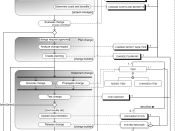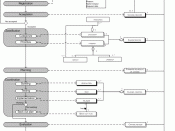Question 6-1: What were the main steps in the change process?
1. Change Process Definition
To management, change process means to prepare, initiate, realize, control, and finally stabilize change processes on both corporate and personal level. The change process comprises four major steps or phases:
"1. Preparation: Identify the legitimate need for change; make key stakeholders aware of the changes required and relevant issues or implications; encourage dialogue among all parties affected by the change; assess readiness to proceed with the change process.
2. Acceptance: Get endorsement by key stakeholders of the chosen direction; secure the necessary support and resources; establish a cross-functional team to design the implementation process and new structure; assess specific needs and goals; develop a vision statement of how the company will operate in the future.
3. Implementation: Analyze the systems and processes involved in the change; redesign the processes; implement the changes.
4. Commitment: Evaluate the outcomes of your change effort based on the original goals; continue to improve the process; ensure continued support for the process."(http://strategis.ic.gc.ca)
2. Main Steps in Change Process of Eastman Chemicals (EC)
The major goal of EC was to enhance product quality, customers' satisfaction and profit.
2.1 Preparations
The first step in change process of EC was preparation. The top management based on SWOT principle identified firm's weakness and strength, and prioritized improvement opportunities. Management found the firm more concentrated in new product creating but overlooked what customers' needs. Besides, product innovation is often the result of bringing to market a new way to provide benefits or value to customers or solve problems, yet, when top management started to think about reengineer the product-innovation process, they found another weakness in EC operation was less communication and cooperation between divisions, it resulted wasting both in time and new products creating. Otherwise,


